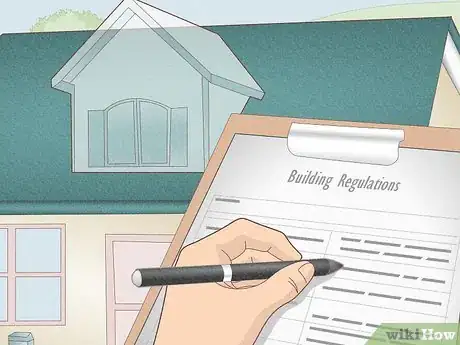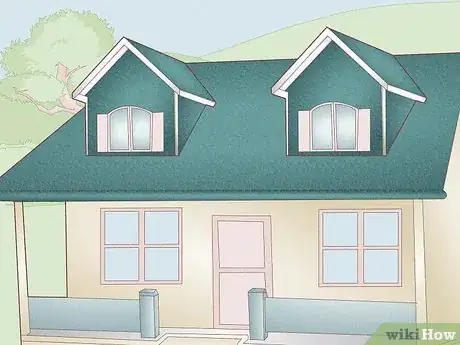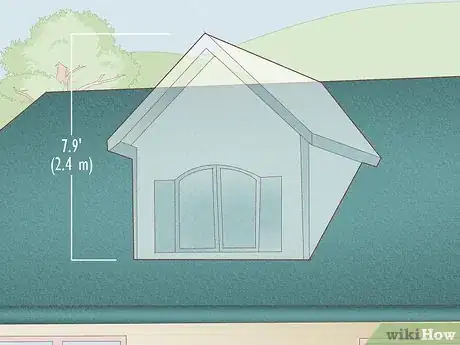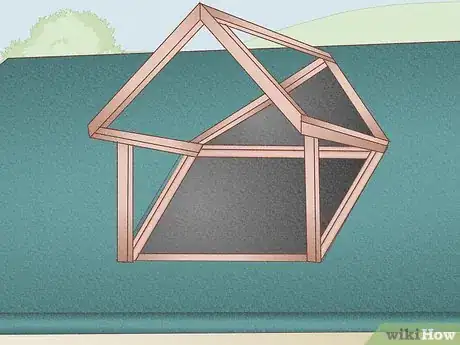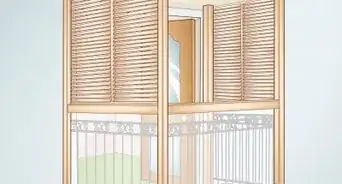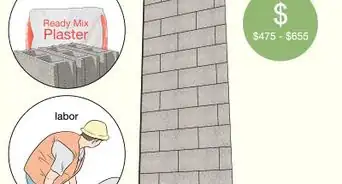This article was co-authored by Alberto DeJesus. Alberto DeJesus is a Construction Specialist and the CEO of DeJesus Industries. With more than four years of experience, he specializes in high-end real estate development and construction. Alberto and DeJesus Industries have been featured on NBC News and have worked with numerous well-known companies, including Mazda, Amazon, and CVS. Alberto holds a Bachelor’s degree from Boston University.
There are 11 references cited in this article, which can be found at the bottom of the page.
This article has been viewed 81,879 times.
A dormer is a roofed vertical addition, usually with a window, that juts out from a pitched roof. Building a dormer on your roof is a great way to add extra living space to your home by taking advantage of unused loft or attic space. This is especially true if you live in a dense urban area where space for other renovations is limited. As long as you have some DIY and construction knowledge, this is a project you can even do yourself. We’ve put together some helpful questions and answers to get you started!
Steps
How big should dormers be?
-
1At least 2.4 m (7.9 ft) tall. The height of a dormer is largely influenced by how tall the roof you’re adding it to is. There’s no hard-and-fast rule for how tall dormers have to be, but making them at least this tall is a best practice that allows for plenty of room to stand in.[3]
- Note that this is the height from the floor to the middle ceiling joist of the dormer.
-
2Make dormers no wider than the home’s windows below. Again, this is just a best practice, but it helps avoid building a dormer that looks disproportionate to the rest of the home. Dormers that are wider than the windows on the home below can end up becoming a dominant architectural feature, rather than a complementary one.[4]
- The architectural features of your home can also guide the width of the dormer. For example, a dormer that’s a little narrower might look best on a house with very classical features, while one that’s a little wider might look better on a house with more horizontal design features.
- Hiring an architect to help you with the design is the best way to make sure you get the dimensions right.
How do you cut a hole in the roof for a dormer?
-
1Rip the roofing material off of the area you want to open up. Wear heavy-duty work gloves and use a clawed hammer to pry up and tear off the tiles or roofing slates. Tear up any underlay and battens as well until the rafters underneath are exposed.[5]
- Keep in mind that in order to do this project yourself, you should be familiar with roofing, framing, and general construction. Otherwise, get a professional to do it for you.
- Get some large waterproof tarps to cover the opening in your roof if it rains. Secure them over the opening by weighing them down with pieces of lumber.
-
2Cut out the rafters in the opening using a reciprocating demo saw. Plug in the demo saw and cut through one end of the first rafter you want to remove. Cut through the other end and remove the section of lumber. Repeat this for all other rafters that are in the area you want to add the dormer to.[6]
- You usually have to remove at least 2 rafters to add a small dormer.
How do you install the framing studs for a dormer?
-
1Attach the middle ceiling joist for the dormer to the main joist in the roof. Screw a joist hanger bracket into the main roof joist in the center of the opening for the dormer. Screw a 2 in (5.1 cm) by 4 in (10 cm) stud to a batten in the middle of the front of the opening. Put the dormer’s ceiling joist in the bracket and screw it into place and screw the stud at the other end to the joist to support it.[7]
- Use a 2 in (5.1 cm) by 6 in (15 cm) or a 2 in (5.1 cm) by 8 in (20 cm) piece of lumber for the ceiling joist.
-
2Install the framing studs on the surrounding raftors. Screw or nail 2 in (5.1 cm) by 4 in (10 cm) pieces of lumber, that are the height of the dormer, to the surrounding rafters vertically every 16 in (41 cm). Put horizontal studs across the tops of the vertical ones.[8]
- If you’re going to install a window in your dormer, frame an opening for the window using shorter vertical and horizontal studs.
-
3Fix angled rafters to the sides of the middle ceiling joist. Cut the ends of 2 in (5.1 cm) by 4 in (10 cm) pieces of lumber to the angle you want the roof of your dormer to slope at. Nail the rafters to the tops of the horizontal framing studs and the sides of the middle framing joist every 16 in (41 cm).[9]
- Note that you only need angled rafters if you’re making a dormer with a gabled roof. If you’re building a flat-roofed dormer, install horizontal rafters.
What should I do after I frame a dormer?
-
1Cover the studs in plywood sheathing and vapor barrier wrap. Nail or screw plywood sheets to the sides of the framing studs and on top of the rafters. Staple vapor barrier wrap to the plywood to moisture-proof it.[10]
- You can also use OSB boards instead of plywood.
-
2Install the window and roofing last. Put the window in the opening you framed if you’re adding a window. Cover the roof of the dormer with roof slates or tiles to match the surrounding roof.[11]
- Adding a dormer is a good time to replace the rest of your roofing as well, so all the materials match and are in equally as good condition.
Expert Q&A
-
QuestionDo you need approval for a dormer?
 Alberto DeJesusAlberto DeJesus is a Construction Specialist and the CEO of DeJesus Industries. With more than four years of experience, he specializes in high-end real estate development and construction. Alberto and DeJesus Industries have been featured on NBC News and have worked with numerous well-known companies, including Mazda, Amazon, and CVS. Alberto holds a Bachelor’s degree from Boston University.
Alberto DeJesusAlberto DeJesus is a Construction Specialist and the CEO of DeJesus Industries. With more than four years of experience, he specializes in high-end real estate development and construction. Alberto and DeJesus Industries have been featured on NBC News and have worked with numerous well-known companies, including Mazda, Amazon, and CVS. Alberto holds a Bachelor’s degree from Boston University.
Construction Specialist Absolutely! You have to go through an architect and engineer to make sure that your home can support the weight that gets anchored to the roof. Once that specification gets approved and stamped, you can send that over to your building department and pay the fee.
Absolutely! You have to go through an architect and engineer to make sure that your home can support the weight that gets anchored to the roof. Once that specification gets approved and stamped, you can send that over to your building department and pay the fee.
References
- ↑ https://www.homebuilding.co.uk/advice/loft-conversion-beginners-guide
- ↑ https://www.cardiff.gov.uk/ENG/resident/Planning/Planning-Policy/Supplementary-Planning-Guidance/Documents/Consultation/Residential%20Extensions%20and%20Alterations%20SPG%20-%20Consultation%20Draft%20June%202017%20English.pdf
- ↑ https://www.independent.ie/life/home-garden/architects-clinic-does-a-dormer-need-planning-permission-39229017.html
- ↑ https://www.finehomebuilding.com/project-guides/framing/designing-gable-dormers
- ↑ https://www.youtube.com/watch?t=11&v=2U9bC1p-2AI&feature=youtu.be
- ↑ https://www.youtube.com/watch?t=30&v=2U9bC1p-2AI&feature=youtu.be
- ↑ https://www.youtube.com/watch?v=2U9bC1p-2AI&t=110s
- ↑ https://www.youtube.com/watch?t=357&v=2U9bC1p-2AI&feature=youtu.be
- ↑ https://www.youtube.com/watch?t=432&v=2U9bC1p-2AI&feature=youtu.be
